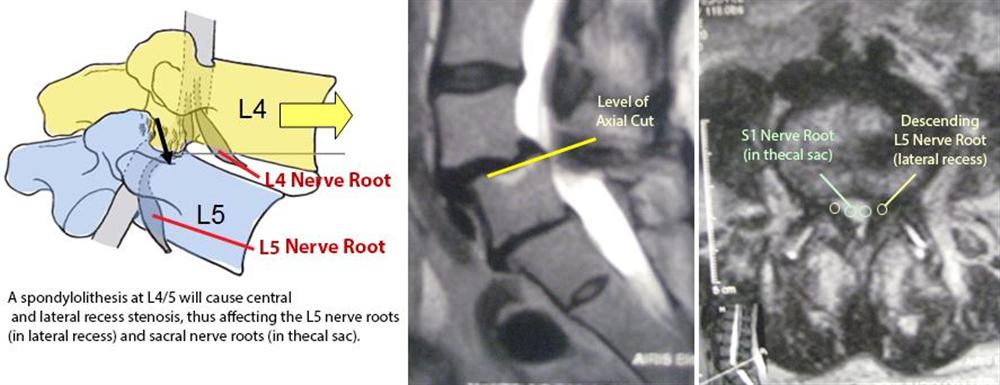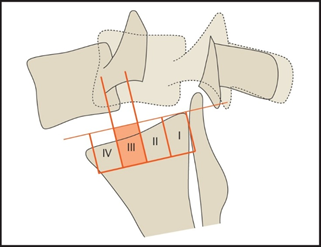

- ⅰ. 선천성: F>M
- ⅱ. 협부형: m/c, M>F, 척추분리증, 대부분 무증상, 제5요추>제4요추,
반복적인 피로골절 및 치유, 신전-회전력, 외상 감별,
협부형은 위로 lysis가 위로 올라가기에 L4 증상이 나타남. - ⅲ. 퇴행성: 주로 40대 이후, M<F, 제4-5요추 호발, 후관절의 퇴행성 변화, 반복적인 굴곡-회전력
L5 증상이 나타남 - ⅳ. 외상성: 대부분 보조기 착용 치유가능
- ⅴ. 병적
- ⅵ. 수술후형
Wiltse Classification is one of the most commonly used classification systems to convey the etiology of spondylolisthesis (see table below). It has five major etiologies: degenerative, isthmic, traumatic, dysplastic, or pathologic.
- Degenerative spondylolisthesis occurs from degenerative changes in the spine without any defect in the pars interarticularis. It is usually related to the combined facet joint and disc degeneration leading to instability and forward movement of one vertebral body relative to the adjacent vertebral body.
- Isthmic spondylolisthesis results from defects in the pars interarticularis. The cause of isthmic spondylolisthesis is undetermined, but a possible etiology includes microtrauma in adolescence related to sports such as wrestling, football, and gymnastics, where repeated lumbar extension occurs.
- Traumatic spondylolisthesis occurs after fractures of the pars interarticularis or the facet joint structure and is most common after trauma.
- Dysplastic spondylolisthesis is congenital and secondary to variation in the orientation of the facet joints to an abnormal alignment. In dysplastic spondylolisthesis, the facet joints are more sagittally oriented than the typical coronal orientation.
- Pathologic spondylolisthesis can be from systemic causes such as bone or connective tissue disorders or a focal process, including infection, neoplasm, or iatrogenic origin.
Additional risk factors for spondylolisthesis include a first-degree relative with spondylolisthesis, scoliosis, or Spina Bifida Occulta at the S1 level

- Grade 1: <25% slip
- Grade 2: 25-50% slip
- Grade 3 50-75% slip
- Grade 4: 75-100% slip
spondylolysis가 L5에 가장 많이 발생하기 때문에 L5/S1 space에서 isthmic type의 spondylolisthesis가 많이 발생하는 반면, degenerative type의 spondylolisthesis는 드물다. 그 이유는 L5/S1은 transverse process가 길고, iliolumbar ligament에 의하여 비교적 stable 하기 때문.
Spondylolysis는 어긋나면서 central canal은 오히려 넓어지고 exit foramen은 좁아져서 upper root증상
Degenerative는 그냥 spinal stenosis처럼 lateral recess 좁아져서 lower root 증상
'신경외과 > Spine' 카테고리의 다른 글
| Discogenic back pain 5 Sx. (0) | 2021.06.11 |
|---|---|
| Axial loaded MRI of the lumbar spine-케이스발표 (0) | 2021.05.02 |
| Unilateral/Bilateral facet dislocation (0) | 2021.01.07 |
| Anterior cervical instrumentation 시 이용할 수 있는 external anatomical landmark (0) | 2021.01.03 |
| Spinal cord injury (1) | 2020.12.29 |
